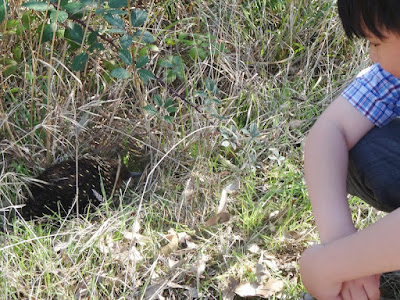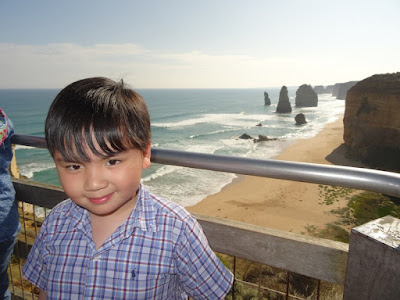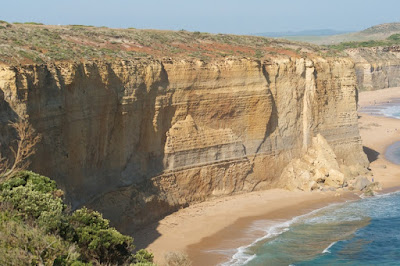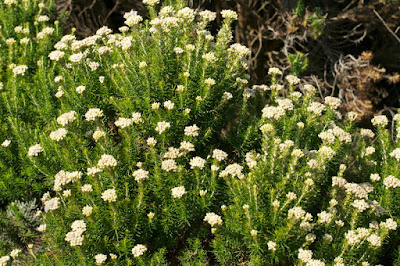Earlier on (see my last post), a group of photographers staring up into tree had led us to a Koala. This time, we came across a group of camera-toting German tourists staring down, into a patch of grass by the roadside. That, to me, suggested that they had found something both interesting and tame, and that meant, in all probability, an echidna. An echidna it was, trundling slowly through the grass, seemingly unconcerned by our presence - a repeat of our previous encounter with its Tasmanian cousin a few days earlier. Ryan was very happy to see it.
The Short-beaked Echidna (Tachyglossus aculeatus) is, of course, an irrestistable creature, perhaps even more so than its cousin the platypus. It's not just that echidnas are cute (though they certainly are). At least for me, it is because they represent a truly ancient lineage.
Though their fossil record only goes back 100 million years or so, they have so many distinct features (not the least that they lay eggs) that they must have branched off the line leading to other living mammals long before that - at least as far back as the middle Jurassic, according to one recent study. That means these little guys, or at least the members of their lineage, have been around for perhaps 165 to 170 million years. Echidnas probably branched away from their platypus cousins as far back as the early Cretaceous. That's impressive.
The echidna having been duly admired, we headed off for the short drive to the Twelve Apostles visitor centre (major tourist attractions always have one of these)....
... and, from there, we walked down to the Apostles themselves.
There are actually only eight apostles left; the ninth collapsed in 2005. A smaller stack nearby collapsed in 2009. Obviously, it is best not to wait if you are planning to go. Apparently the formation was once known as the Sow and Piglets, which, if less evocative, avoided the risk of becoming obsolete as the south coast continues to be eroded by the sea.
By now it was afternoon, and the light was best looking eastward even if the better-known stacks were to the west.
We were not inspired to join the surprising number of visitors who seemed unaware, or unconcerned, about the recent geological history of the place.
On the other hand, maybe the intrepid souls clambering over the rocks in front of us just couldn't read.
There was plenty to see from the lookout without unnecessary risk to life and limb, including the handsomely stratified coastal cliffs.
The coastal scrub behind the cliffs was interesting too - a combination of coarse grasses and densely-packed, salt-resistant heath vegetation.
A convenient sign in the lookout area helped to identify some of the commoner plants.
Pigface (Carpobrotus sp.) scrambles over the clifftops; this may well be a mixture of both native and introduced species, both of which occur in the region.
Coast Everlasting (Ozothamnus turbinatus) grows abundantly here; like other everlastings it is a composite, a member of the daisy family (Asteraceae).
Coast Cushion Bush (Leucophyta browni), another composite, gets its silvery sheen from a coating of woollen hairs. Its fruiting heads, dried and brown during our visit, sport yellowish blooms in the flowering season.
Seaberry Saltbush (Rhagodia candolleana), a member of the goosefoot family or Chenopodiaceae (and sometimes included in the genus Chenopodium), sports berries that look rather like small gummy candies. I gather that they are quite tasty - something I learned after our visit, so I can't speak from personal experience!
By now it was time for us to head back to Melbourne, and to get ready for our flight back to Malaysia the next day. For my final photo from Australia, here is a Welcome Swallow (Hirundo neoxena); I will take its name as an invitation to come back.
































No comments:
Post a Comment